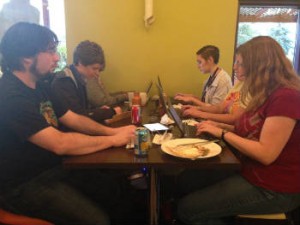Tags
Related Posts
Share This
NaNoWriMo: 30 days to write that novel

From left, Guillaume Hébert-Jodoin, Laurel Harris, Althea Nawalleh, Helena Verdier, Marie-Christine Houle, and Carol Brereton at a Luna Café write-in. [Photo © Jon Willemsen]
The reason for their gathering was to further an individual, yet collective, goal: to each write a 50,000-word novel entirely in the month of November, as part of a completion called National Novel Writing Month—or NaNoWriMo, as it is affectionately known by its willing participants.
“It’s absolutely insane, but it’s a challenge and it’s a lot of fun,” says a smiling Helena Verdier, one person at the table.
Verdier, 21, is one of three NaNoWriMo liaisons in the Ottawa region. She balances that volunteer role with a full-time job at a car dealership, along with writing her own novel. She’s in charge of coordinating NaNoWriMo writers’ meetings around the city for the month of November. These meetings are called “write-ins,” where writers meet new faces or catch up with old friends, then sit down together and start writing.
‘At every write-in event, I’m seeing new faces, which means more people are doing it.’ – Guillaume Hébert-Jodoin, NaNoWriMo participant
Verdier, who organizes and attends write-ins “almost every day” in November, says they are the most productive way to achieve the daunting 50,000-word goalpost. “You really need that community support,” she admits. “There are days where you don’t want to write, but seeing other people work hard pushes you to keep going.”
A global movement
![National Novel Writing Month has grown into an international non-profit organization, with more than 300,000 people participating in November 2013. [Photo courtesy of National Novel Writing Month]](http://www.cusjc.ca/capitalarts/wp-content/uploads/nanowrimo-205x300.jpg)
Warriors of the pen. The NaNoWriMo logo references the hell-bent Vikings. [Photo courtesy of National Novel Writing Month]
Since 1999, NaNoWriMo has evolved into a southern California–based non-profit organization, dedicated to helping encourage writing around the world. While the cost is free for anyone to join in writing her or his own novel, participants are encouraged to donate to the organization, to help fund its youth literacy initiatives: Camp NaNoWriMo and the Young Writers Program, both designed to provide a community and resources to hopeful young writers.
The major idea, for most participants, is to knock off a novel first draft. Even if that draft isn’t yet publishable, it may provide the author with a literary agent or a publisher willing to provide editing in order to publish it.
NaNoWriMo has led to a number of successes. Among the noteworthy published novels to have come out of the event in the last 15 years are Sara Gruen’s Water for Elephants, Erin Morgenstern’s The Night Circus, Hugh Howy’s Wool, and Marissa Meyer’s Cinder.
Alan Averill, a Seattle-based author, wrote the first draft of his novel The Beautiful Land during NaNoWriMo. Eventually the book was published in 2013 by ACE/Roc Books, a division of Penguin Books. But Averill he says the road to publication was far from easy: He spent an entire year simply trying to find a literary agent, and, even so, a book deal was reached only after the manuscript had won the Amazon Breakthrough Novel Award.Averill credits NaNoWriMo with helping him to focus on at least finishing the manuscript: “I’ve wanted to be a professional writer since I was a little kid, so I suppose in that way I was thinking about getting it published. But it didn’t seem like any kind of realistic goal.”
In Ottawa, NaNoWriMo has been a fixture for about the past decade, according to Guillaume Hébert-Jodoin. The 33-year-old University of Ottawa law student and writer, who served as Ottawa community liaison for the prior two years, believes that November 2014 has drawn some of the largest write-in crowds he can remember. “At every write-in event I go to, I’m always seeing new people,” he says. “Of course, there’s that core group of people you see every time, but most times this year I’m seeing new faces every week, which means more people are doing it.”
Nearly 4,000 participants in the Ottawa-Gatineau region were officially registered as members in November, according to the NaNoWriMo website. Hébert-Jodoin estimates that each of the daily write-ins draws about 10 to 20 people (with far more showing up for the larger, community-wide events). He recalls significantly fewer people attending such events in 2013.
Daunting task, distant finish
![Verdier serves as one of the Ottawa community liaisons this November, and she has to balance the demanding volunteer commitment with her full-time job. [Photo © Jon Willemsen]](http://www.cusjc.ca/capitalarts/wp-content/uploads/helena-225x300.jpg)
Helena Verdier: ‘You’re encouraged to keep going, dreaming of writing your own novel.’ [Photo © Jon Willemsen]
Meagan Black knows the difficulty first hand. The fourth-year English student at Carleton University has attempted NaNoWriMo twice, both times unsuccessfully. She says it simply was taking too much of her time. Another factor, she says, was frustration: “I just wasn’t happy with what I was writing. It makes it hard to motivate yourself to keep going when you aren’t happy with where the story is going and you’re spending so much of your time writing.”
Still, habitual NaNoWriMo participants consider the concept of a-novel-in-a-month to be very healthy, since it banishes procrastination and perfectionism. It gives authors the incentive to crank out chapters and reach the story’s end, no matter how imperfectly, as opposed to rewriting constantly and getting caught in a loop.
“It’s not about the quality of what you’re writing, but the quantity,” explains Verdier. “You can go back and edit your story whenever you want. But you’re always encouraged to keep going by seeing everyone else working hard and dreaming of writing your own novel. And that’s what makes NaNoWriMo worth it.”






![The cover page for Averill’s NaNoWriMo novel, The Beautiful Land, which after years of revising and searching for a publisher was finally published in 2013. [Photo courtesy of Alan Averill]](http://www.cusjc.ca/capitalarts/wp-content/uploads/averill-197x300.jpg)